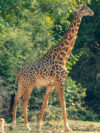Lion Research and Conservation in Luambe National Park
Tags: Research, Zambia
Implementing Partner: Zambian Carnivore Programme
Luambe’s Lions
The situation of lions is dramatic. The species is highly endangered. Their African range has shrunk by over 90%. The population number of free-ranging lions is estimated to be a mere 1,000 animals in only nine African states (2). – The population numbers of free-ranging lions are estimated to be a mere 1,000 animals in only nine African states (2).
The causes are the collapse of prey populations due to poaching, preventive killing to protect humans and domestic animals, unregulated commercial lion hunting, and the use of their body parts for traditional Chinese medicine.
Zambia’s total lion population is estimated at 1,200 animals, geographically divided between the Greater Kafue ecosystem and the Luangwa Valley. The Luangwa Valley ecosystem covers an area of about 70,000 km² of unfenced, virtually untouched wilderness – home to Zambia’s largest lion population.
Despite the small size of Luambe National Park, two lion prides were resident here in the early 2000s. However, due to illegal trophy hunting of male lions until the recent past, the social structures of the prides were severely affected. As a result, there were hardly any offspring among the over-aged female lions.
The theory behind this: defenceless lion cubs that had lost their fathers due to illegal hunting activities were killed by male lions from the rival pride. These males advanced into the area to produce offspring themselves and took over the pride, eliminating any male cubs fathered by previous resident males. This process continued in Luambe National Park for a period of at least 20 years.
The northern border of Luambe National Park has not been accepted by commercial big game hunters for many years. Only in 2023, the Department of National Parks and Wildlife in Zambia gazetted the official boundary of Luambe. Because of the year-long uncertainty, the park lost lions and leopards on a yearly basis due to big cat hunting tolerated by the authorities as part of international hunting tourism.
Since Luambe Camps & Conservation has been developing its work on the ground, the conditions for illegal trophy hunting have become much more difficult, but big cats were still hunted in the national park in 2021. Only in 2023, it has become possible to sustainably protect Luambe’s big cats and keep the hunters out of the park.
Over the years, with the help of camera traps and direct observations by the Zambian Carnivore Programme (ZCP), a number of different lions have been identified and catalogued in Luambe. Most of them were male, and the few females were mostly extremely shy.
In collaboration with ZCP and with financial support from C4C, a satellite telemetry project was finally launched. In October 2018, the first lioness was fitted with a tracking collar, followed by two more in 2020. Through the transmitters, it is possible for ZCP’s lion researchers to track the movements of the female lions, but also to determine possible additions to the pride.



